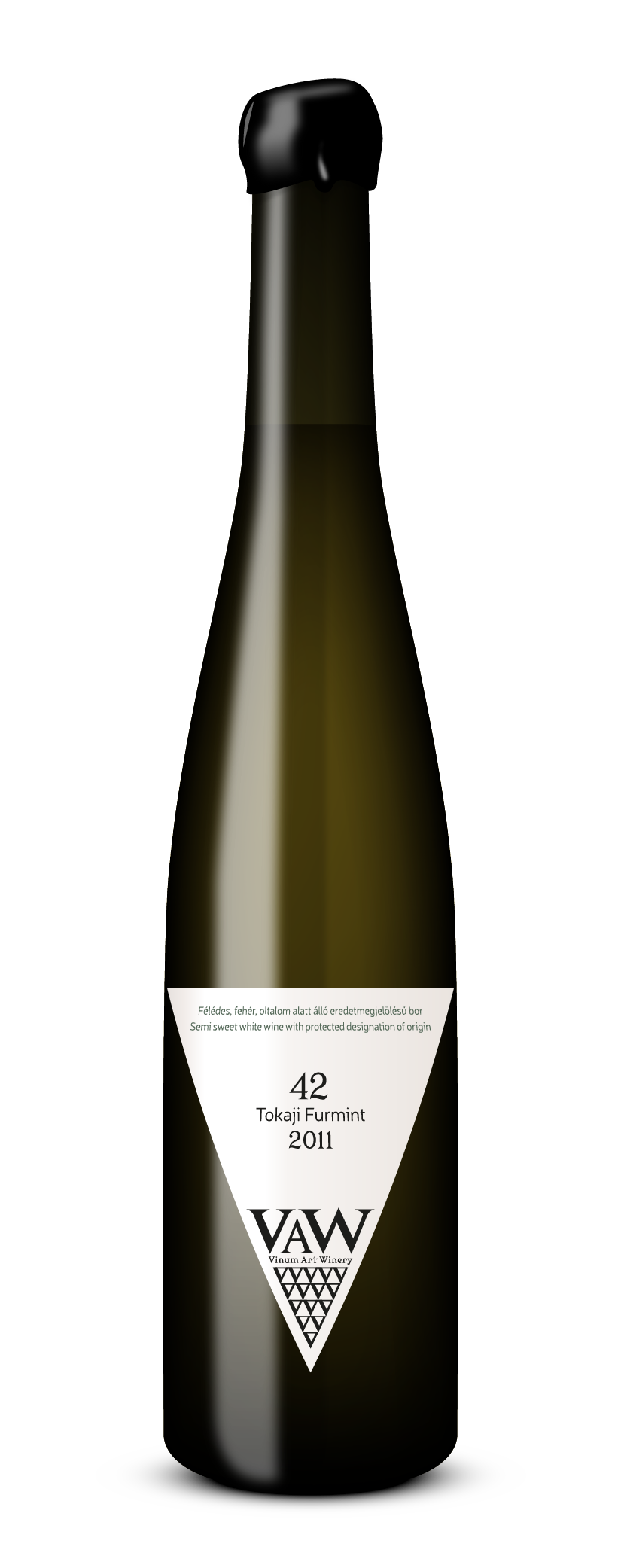Personal opinion:
For me, the spicily sweetish taste, impregnated with aszú-like aromas accumulated during 42 years in the 700-litre barrel, is fascinating. The wine spent 16 months in a 1971 wooden barrel in which they matured aszú in the first 20 years, and it worked wonders on this wine.
Definitely a unisex wine, moreover it is rather sociable.
Gastronomical pairing:
We can compensate the sweetness of the wine by consuming air-dried cured ham – that is what I did, too!
About the Furmint variety:
The Furmint (or ‘furmin’ – as it is also referred to in Hungarian) is a grape variety suitable for making white wine.
In Hungary it is the eighth most prevalent variety.
This grape is the base for the sweet Tokaj aszú. In the Tokaj wine region its harvest traditionally starts on October 28, the day of Simon and Júda.
The Pontian Balcanica branch belonging to the wine producing varieties (Vitis vinifera) of the Vitaceae family, is a typical Hungarian variety and the Hungarian grape that best shrivels for making aszú wine. Its origin is not precisely known – some believe it originates in southern Italy, some think it is the ‘Szerémség’ area located in today’s Croatia and Serbia, but it may even be from today’s Hungary.
Within the variety we differentiate white, red, and changing Furmint. The most prevalent, dominant variety is the white Furmint which is a late-ripening type, ripening in the second half of October. Its vine-stock has powerful growth, is not demanding regarding the soil, and is a moderate to good cropper. Its leaves are shallow-lobed, their width and length are practically the same, and they are thick and slightly blistery. Its cluster is loose, medium-sized, its berries are also medium-sized, yellowish green, rusty on their sunny side, with a long stem, slightly thick skin, crunchy, succulent, and when really ripe, they shrivel well. It is prone to Botrytis, but in favourable years, rot is of the noble rot type.
The region and its history:
It cannot be established with surety today who originally planted the southern slopes of the Tokaj region (Hegyalja) with vine. It is, however, certain, that there was viniculture here already before the settlement of the Magyars in Hungary.
After the invasion of the Tatars (1241-1242) Béla IV invited Italian grape-growers into the country who settled in Olaszi (Bodrogolaszi), Sárospatak and Liszka (Olaszliszka). They, the Italian viniculturists, were the ones who laid the basis of international fame for the wine region, bringing with them the varieties of their homeland located more to the south. It is also a proven fact that the most illustrious variety in Tokaj, the Furmint, is also of Latin or Italian origin („mea nec Falernae temperant vites, neque Formiani pocula colles” [Horatius]).
The name Tokaj-Hegyalja came from the town of Tokaj and from the surrounding region originally only named Hegyalja (“piedmont”). The Hungarian name ‘Hegyalja’ was already in use in the 16th century. The Latin name of the region, Districtus Submontaneus or “Piedmont region” also appeared later as a public administration title.
The Tokaj castle was known all over Europe in the 16th-17th centuries, so foreign wine merchants looked for “Tokaj wine” in the entire “Hegyalja” region and the region became known all over Europe as “Tokaj’s highland” (in Latin: Montium vitiferorum Tokaiensis, in German: Tokayer Gebürg or Tokajer Wein-Gebürg). This was slowly neutralized also in the Hungarian parlance, and the area was called “Tokaj-Hegyaljának” from the 18th century onwards, besides the official “Hegyalja” name. The latter was only replaced officially by the name “Tokaj-Hegyalja” from the early 20th century.
It is an old saying that the Tokaj wine is the king of wines and the wine of kings. This divine wine speciality truly is the most distinguished of the premier Hungarian varieties, and it is also a fact that several royalties had the bottled Tokaj wine on their table. Not only royalties, however, but also the uncrowned monarchs of the arts.
(e.g.: Mozart, Goethe, Schubert, Baumberg, Rossini).
Climate and geography:
The Tokaj wine region is situated in an 87-kilometre long and 3-4-kilometre wide area of 5500 hectares, in a triangle bordered by three characteristic hills, that of Abaújszántó, the Sátor-hill of Sátoraljaújhely, and Tokaj’s Kopasz-hegy, bordered by 28 settlements.
The Tokaj wine region has a continental climate. In most places there is volcanic base-soil (andesite, rhyolite, and the tuffs of these), and black soil, rich in humidity, that evolved on this. On the volcanic rock, rich in minerals, full-bodied wines with vivid acids and mineral notes can be produced.
Because of the lower acid content, parts with yellow soil (e.g. the Kopasz-hill) are favourable for wines of a softer character; these slopes are more suitable for growing more fragrant varieties.
Botrytis cinerea – that causes the aszú process or noble rot – is not only characteristic of Tokaj-Hegyalja, but can also be found in other wine regions (Arad-hegyalja, Mór). However, due to the combination of the production site, the special micro-climate, the surrounding rivers (Bodrog, Tisza) and the right wine variety (Furmint, Hárslevelű or “Linden leaf”, Muscatel, Zeta, Kövérszőlő or “Fat grape”, Kabar) the aszú process occurs here, year after year. A characteristic feature of the cellar system of the wine region that is carved out of rhyolite tuff is the noble mould, Cladosporium cellare, covering the walls in a thick layer. W This is only found here and in the Rhein wine cellars, in the world. This fungus plays an important role in ensuring the quality of Tokaj wines.
NAME: “42”
YEAR: 2011
VARIETY: Tokaji Furmint
DISTRICT: Tokaj
CLASS: Semi-sweet white wine with protected designation of origin
Product of Hungary
Bottle volume: 750ml
Alc.13,5%vol
Contains sulphites


